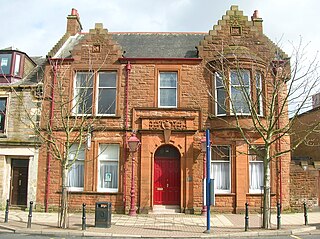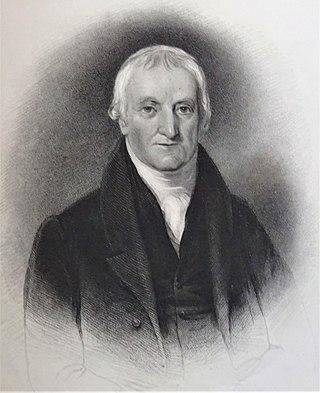
Ayrshire is a historic county and registration county, in south-west Scotland, located on the shores of the Firth of Clyde. The lieutenancy area of Ayrshire and Arran covers the entirety of the historic county as well as the island of Arran, formerly part of the historic county of Buteshire. Its principal towns include Ayr, Kilmarnock and Irvine and it borders the counties of Renfrewshire and Lanarkshire to the north-east, Dumfriesshire to the south-east, and Kirkcudbrightshire and Wigtownshire to the south. Like many other counties of Scotland, it currently has no administrative function, instead being sub-divided into the council areas of East Ayrshire, North Ayrshire and South Ayrshire. It has a population of approximately 366,800.

Irvine is a town on the coast of the Firth of Clyde in North Ayrshire, Scotland. The 2011 Census recorded the town's population at 33,698 inhabitants, making it the largest settlement in North Ayrshire.

Joanna Southcott was a self-described religious prophetess from Devon, England. A "Southcottian" movement continued in various forms after her death; its eighth prophet, Mabel Barltrop, died in 1934.
Elspeth Buchan (1738–1791) was the founder of a Scottish religious sect known as the Buchanites.

During the years 1781–1782, at the age of 23, Robert Burns (1759–1796) lived in Irvine, North Ayrshire for a period of around 9 months, whilst learning the craft of flax-dressing from Alexander Peacock, who may have been his mother's half-brother, working at the heckling shop in the Glasgow Vennel. Dr John Cumming of Milgarholm, a provost of Irvine, claimed that he had invited Burns to come to Irvine to learn flax dressing. During this time he made a number of acquaintances, befriended several locals and took regular walks into the Eglinton Woods via the old Irvine to Kilwinning toll road and the Drukken or Drucken (Drunken) Steps. Steps over the Red Burn and back via the site of Saint Brides or Bryde's Well at Stanecastle. Burns had several other connections with the Eglinton Estate and other branches of the Montgomerie family. He probably left in March 1782.

Trindlemoss Loch, Scott's / Scot's Loch or the Loch of Irvine was situated in a low-lying area running from Ravenspark to near Stanecastle and down to Lockwards, now represented only by the playing fields off Bank Street in the Parish of Irvine, North Ayrshire, Scotland. The loch was natural, sitting in a hollow created by glaciation. The loch waters were progressively drained and in 1691 this was finally achieved.

Crocketford also known as Ninemile Bar, as it is approximately equidistant between Castle Douglas and Dumfries, is a village in the historical county of Kirkcudbrightshire in the Dumfries and Galloway council area near the boundary between Scotland and England. It is located on the A75 road around 9 miles (14 km) west of Dumfries. Crocketford is one of only two settlements that are not bypassed by the A75 along with Springholm, around 2 miles (3 km) to the south-west.

Lesley Baillie (1768–1843), later Mrs Lesley Cumming, was born at Mayville, Stevenston, Ayrshire. She was a daughter of Robert Baillie and married Robert Cumming of Logie, Moray. Her lasting fame derives from being Robert Burns's 'Bonnie Lesley', "the most beautiful, elegant woman in the world". On her tombstone her name is given as Leslie Baillie.

The Irvine Burns Club, based at the Wellwood Burns Centre & Museum, was founded on 2 June 1826 and is one of the world's longest continuously active Burns Clubs. At least five personal friends of Robert Burns were among the group of local gentleman, whose idea it was to form the club. Irvine in North Ayrshire is an old market town and port situated on the west coast of Scotland, approx 14 miles north of Ayr.
Jean Gardner or later Jean Hill, was "a young woman of very surpassing beauty," with a "light foot and an ensnaring eye," but she may have been thirteen years older than Robert Burns with whom she was on friendly or 'intimate' terms. A strong local tradition in Irvine links her with Robert Burns, however no contemporary written evidence records this relationship and Burns himself is not thought to have written about her, other than a disputed use of her given name as the 'darling Jean' of Burns's 'Epistle to Davie', and most recent writers have considered the reference to be to Jean Armour.

Robert Burnes or Robert Burness was a paternal uncle of the poet Robert Burns. He left the family farm of Clochnahill or Clokenhill in Kincardineshire with his younger brother William Burnes, and found work at the Lochridge or Lochrig limestone quarries and lime kilns that lay near Byrehill Farm near Stewarton. He was a teacher, a gardener later in life and a land steward on the nearby Robertland Estate, possibly through the influence of his nephew. Robert Burns referred to his him as Poor Uncle Robert upon his death in 1789.

William Jaffray was an English-born publisher and politician in Waterloo County, Ontario, Canada. He served as the mayor of Berlin, Ontario from 1882 to 1883.

Brownhill Inn, now just called Brownhill, was an inn approximately 1 mile (1.6 km) mile south of Closeburn, on the A76, which itself is about 2 miles (3.2 km) south of Thornhill, in Dumfries and Galloway, Scotland. Built in approximately 1790, this old coaching inn has undergone extensive changes, and the south side of the original property appears little changed whilst part of the inn has been demolished. The inns facilities used to include the once-extensive 12 stall livery stables on the west side of the road, but these have been sold and converted to farm buildings after the inn closed. The inn was the first changing place for horses hauling coaches from Dumfries and closed in 1850. In 1789 an Act of Parliament had been passed that enabled the building of a Turnpike from Auldgirth Bridge to Sanquhar through Closeburn Parish and the inn was built to serve the patrons of this new road. The toll road supplanted the original post road that ran via Stepends, Gateside and Shaw that may have been of Roman origins.

The Woman Clothed with the Sun; being The Confession of John McHaffie concerning his sojourn in the Wilderness among the folk called the Buchanites, is a historical novella by the British writer F. L. Lucas. It purports to be an account, written in 1814 by a Scottish minister of the Kirk in middle age and published posthumously, of his youthful bewitchment by Elspeth Buchan and of the time he spent in the 1780s among the Buchanites. First published in 1937, it was Lucas's second historical novella, the first being The Wild Tulip (1932); he had also published a prize-winning historical novel, Cécile (1930).

John Syme was a Scottish lawyer and one of the poet Robert Burns's closest friends during his time in Dumfries. In the summers of 1793 and 1794 he joined Burns on his two short tours of Galloway. Syme and Alexander Cunningham were amongst the most active of the friends and admirers of Burns's works who raised funds for the poet's family and for his mausoleum with the assistance of others such as James Currie. Together with Dr Willam Maxwell he arranged Burns's funeral.

John Bacon was a vintner, the landlord at the one time important hostelry named the Brownhill Inn, that lay in open country to the south of Closeburn in Nithsdale on the Ayr to Dumfries Road. From 1788 to 1791 the poet Robert Burns spent many an evening at Bacon's inn whilst travelling on his Excise duties. A coaching stop and hostelry, the inn lay about 7 miles north of Ellisland Farm, Burns's home before the family moved into Dumfries. During their tour of August–September 1803 Dorothy Wordsworth, with her brother William Wordsworth and mutual friend Samuel Taylor Coleridge were hosted by Bacon and his wife at their inn.

Edward Whigham (1750–1823) was the landlord of a coaching inn, a bailie, Provost of Sanquhar, bibliophile and one of Robert Burns's close friends during his Nithsdale and Dumfries days. Edward married Jane Osborne who died on 6 October 1846.

James Glencairn Burns (1794–1865) was the fourth son and eighth child born to the poet Robert Burns and his wife Jean Armour. James was born at their home in Mill Brae Street, now Burns Street in Dumfries on 12 August 1794. His first and middle name was added in honour of James Cunningham, 14th Earl of Glencairn, Robert's friend, patron and mentor.

William Nicol Burns (1791–1872) was the sixth child, third born and second surviving son born to the poet Robert Burns when he was 32 and his wife Jean Armour was 26. William was born at Ellisland Farm in Dunscore parish, shortly before the family moved to Dumfries in 1791. His first and middle name was added in honour of William Nicol, Robert's friend.
Joseph Train was a Scottish excise officer, antiquarian, writer and poet. He corresponded with Sir Walter Scott, and his local knowledge provided Scott with ideas for his novels.

















